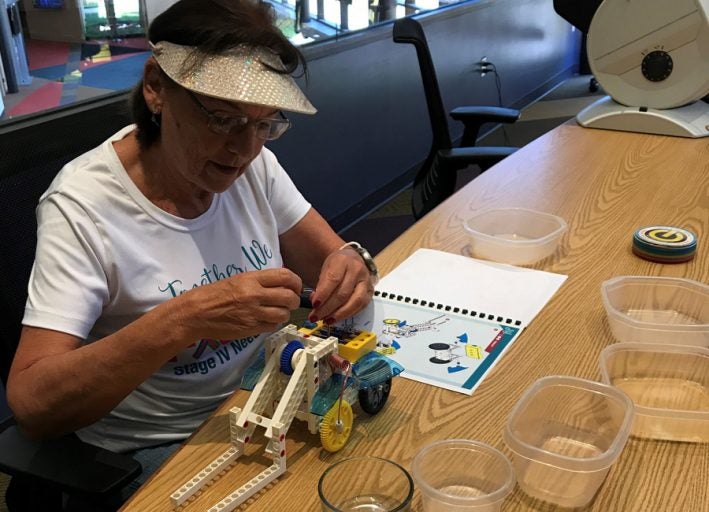None of us is getting any younger, and for that reason alone researchers of an interdisciplinary project at UCF want to introduce some of us to the benefits of robots – but maybe not in the way you expect.
These aren’t robots to take out the garbage or play chess.
Instead, they are small assembly-kit robots built by people 55 and older who may be experiencing age-related physical and cognitive decline. Researchers want to see if the model sets have any impact, and are redesigning off-the-shelf kits to make them more accessible for the study’s subjects. While the team is still assessing participants’ abilities and the barriers in building the kits, one benefit is already clear: The kits provide people with another outlet for socialization.
“A couple of years ago we were working with teachers at the Orlando Science Center and having them do commercially available robot-kit assembly,” said Stella Sung, director of UCF’s CREATE (Center for Research and Education in Arts, Technology and Entertainment) at the downtown Center for Emerging Media, where much of the research is taking place. Both are part of the College of Arts & Humanities.
“The kits were fun, but I got to thinking that they were all designed for kids and youngsters, and that some older people would have a hard time doing some of the tasks. The parts are small, the instructions are not always very clear, etc.”
Sung checked to see if there was anything similar on the market specifically for that demographic, but she said she discovered there was nothing to compare.
So she partnered with psychology Professor Janan Smither in the College of Sciences to create a project they’ve been calling the Silver Robot Kit. The team is creating the kits geared for 55 and older adults and researching the impact on cognitive and physical skills.
Smither, whose interests include technology and aging, and two of her students earlier this month attended the British Society of Gerontology International conference in Wales and presented the kit project, which won second place out of more than 40 gerontology studies.
“These robotic kits can provide a fun and cognitively stimulating leisure activity,” Smither said. “This activity can conform to the interests of the more technology-savvy older adult as well as provide an outlet for socialization with other older adults or bridge the generational gap, as it can be a fun activity to build a kit with grandkids.”
The team is researching off-the-shelf products to develop Silver Robot Kits with large-print instructions, easier-to-follow drawings and pictures, and brighter colors. Next they plan to make prototypes using 3-D printers and gain enough traction so that companies will make and market the kits commercially.
“One of the things that we noted about many (available) kits is that the colors are limited to industrial grey, blue, black, white colors,” Sung said. “We would like our robots to be colorful, artistic and creative, and include sound and light elements as well.” As the project progresses, the team plans to involve the School of Visual Arts & Design.
For their research, the team has been organizing “team builds” at CREATE and Smither’s Technology and Aging laboratory on campus, where the volunteer participants build small robots to test workable and inadequate designs. About 30 participants have helped with assembly projects so far, but the team plans to take the test kits to senior centers for more study.
“At the beginning, I thought that these kits could be created for recreational and intergenerational purposes. However, since then, we’ve engaged in a research agenda that further explores the purposes of the kits and how they might enhance various skills,” Sung said. “The kits could also be used for others with certain disabilities. We are still deciding what functions the robots will do. At present, they would be designed for entertainment purposes, but I believe that we’ll eventually be able to have the robots programmed to serve other purposes.”
Sung said some of the participants have commented that because of their hearing loss they often feel isolated in group activities. But with the Silver Robot Kits, she said they can assemble them as a group or individually in a socialized setting.
“Still others have responded that the activity gave them a sense of having accomplished something which they thought that they would not be able to do,” she said.
Four doctoral students in Smither’s laboratory are working on the project. Eva Parkhurst, Jessica Michaelis, Fernando Montalvo and Michael Rupp are assessing participants’ abilities and dexterity, barriers in building the kits, existing commercial assembly instructions, and other factors.
“We are pursuing the development of robotic kits because this is a popular modern activity that a lot of older adults have never even considered attempting,” said graduate research assistant Eva Parkhurst. “I personally love to see the look on the faces of our participants when they start using the remote control to move the robot that they built with their own hands.”
The team hopes to eventually see an entire line of products specifically designed for the target demographic.
“As the next generations of aging adults approach, the use of technology and what technology can do is becoming more and more a part of daily life,” Sung said. “One of the goals of the robot kits is to introduce them to the increasing ways in which tech influences their lives as well as the lives of all around them.”
